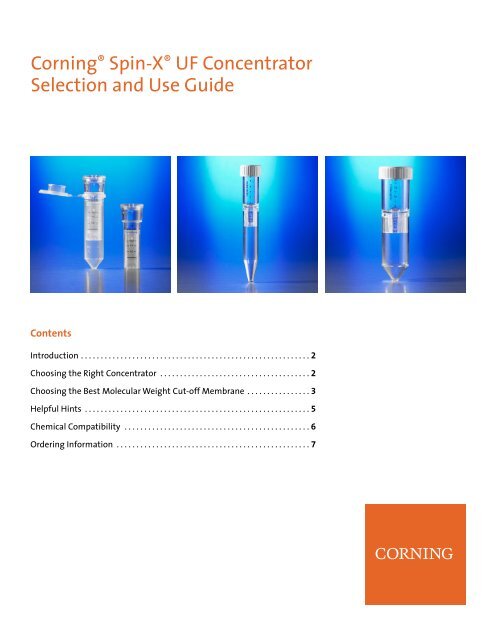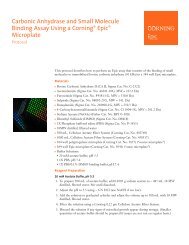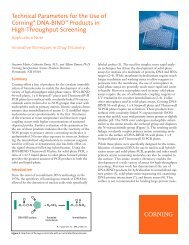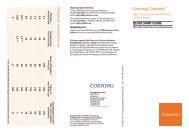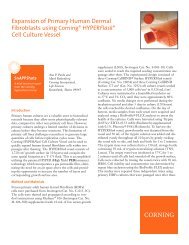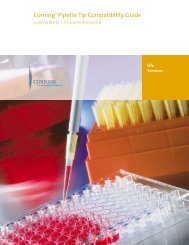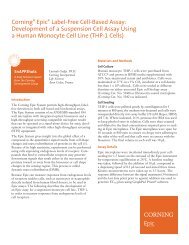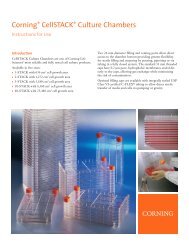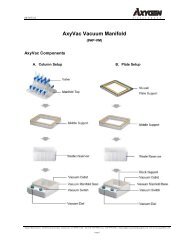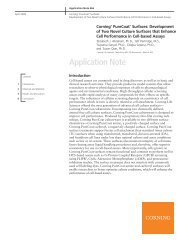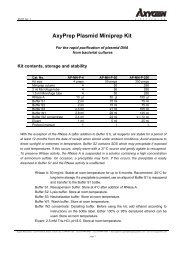Spin-X UF Concentrator Selection and Use Guide - Corning ...
Spin-X UF Concentrator Selection and Use Guide - Corning ...
Spin-X UF Concentrator Selection and Use Guide - Corning ...
Create successful ePaper yourself
Turn your PDF publications into a flip-book with our unique Google optimized e-Paper software.
<strong>Corning</strong> ® <strong>Spin</strong>-X ® <strong>UF</strong> <strong>Concentrator</strong><strong>Selection</strong> <strong>and</strong> <strong>Use</strong> <strong>Guide</strong>ContentsIntroduction . . . . . . . . . . . . . . . . . . . . . . . . . . . . . . . . . . . . . . . . . . . . . . . . . . . . . . . . . . 2Choosing the Right <strong>Concentrator</strong> . . . . . . . . . . . . . . . . . . . . . . . . . . . . . . . . . . . . . . 2Choosing the Best Molecular Weight Cut-off Membrane . . . . . . . . . . . . . . . . 3Helpful Hints . . . . . . . . . . . . . . . . . . . . . . . . . . . . . . . . . . . . . . . . . . . . . . . . . . . . . . . . . 5Chemical Compatibility . . . . . . . . . . . . . . . . . . . . . . . . . . . . . . . . . . . . . . . . . . . . . . . 6Ordering Information . . . . . . . . . . . . . . . . . . . . . . . . . . . . . . . . . . . . . . . . . . . . . . . . . 7
Introduction<strong>Corning</strong> ® <strong>Spin</strong>-X ® <strong>UF</strong> concentrators are disposable, single use only ultrafiltration devices withpolyethersulfone membranes (PES) for the centrifugal concentration <strong>and</strong>/or purification ofbiological samples. This guide will help you chose the best <strong>Spin</strong>-X <strong>UF</strong> concentrator for yourapplication.Major <strong>Use</strong>s for UltrafiltrationUltrafiltration is a convective process that uses anisotropic semi-permeable membranes toseparate macromolecular species <strong>and</strong> solvents primarily on the basis of size. It is particularlyappropriate for the concentration of macromolecules <strong>and</strong> can also be used to purify molecularspecies or for solvent exchange (Table 1). Ultrafiltration is a gentle, non denaturing methodthat is more efficient <strong>and</strong> flexible than alternative processes.Solute ConcentrationUltrafiltration membranes are used to increase the solute concentration of a desired biologicalspecies. The filtrate is cleared of macromolecules which are significantly larger than the retentivemembrane pores. Microsolute is removed convectively with the solvent.Solute Desalting or PurificationA solution may be purified from salts, non-aqueous solvents <strong>and</strong> generally from low molecularweight materials. Multiple solvent exchanges will progressively purify macromolecules fromcontaminating solutes. Microsolutes are removed most efficiently by adding solvent to thesolution being ultrafiltered at a rate equal to the speed of filtration. This is called diafiltration.Table 1. Typical Ultrafiltration Applications◗ General purpose laboratory concentration <strong>and</strong> desalting of proteins, enzymes, cells, biomolecules,antibodies <strong>and</strong> immunoglobulins◗ Removal of labeled amino acids <strong>and</strong> nucleotides◗ HPLC sample preparation◗ Deproteinization of samples◗ Recovery of biomolecules from cell culture supernatants, lysatesChoosing the Right <strong>Concentrator</strong><strong>Corning</strong> offers <strong>Spin</strong>-X <strong>UF</strong> concentrators in three sizes. The information below <strong>and</strong> Tables 2<strong>and</strong> 3 will help you find the best concentrator for your needs.1. <strong>Spin</strong>-X <strong>UF</strong> 500 for 100 to 500 µL samples<strong>Spin</strong>-X <strong>UF</strong> 500 µL centrifugal filter units offer a simple, one step procedure for sample preparation.They can effectively be used in fixed angle rotors accepting 2.2 mL centrifuge tubes.The vertical membrane design <strong>and</strong> thin channel filtration chamber minimizes membranefouling <strong>and</strong> provides high speed concentrations, even with particle laden solutions.2. <strong>Spin</strong>-X <strong>UF</strong> 6 for 2 to 6 mL samples<strong>Spin</strong>-X <strong>UF</strong> 6 mL concentrators have been developed to offer increased volume flexibility <strong>and</strong>performance. <strong>Spin</strong>-X <strong>UF</strong> 6 concentrators can process up to 6 mL in swing bucket or fixedangle rotors accepting st<strong>and</strong>ard 15 mL conical bottom tubes. In a single spin, solutions canbe concentrated in excess of 100-fold. Samples are typically concentrated in 10 to 30 minuteswith macromolecular recoveries in excess of 95%.The <strong>Spin</strong>-X <strong>UF</strong> 6 features twin vertical membranes for unparalleled filtration speeds <strong>and</strong>100x plus concentrations. Remaining volume is easy to read off the printed scale on the sideof the concentrator <strong>and</strong> the modified dead stop pocket further simplifies direct pipet recoveryof the final concentrate.2
3. <strong>Spin</strong>-X ® <strong>UF</strong> 20 for 5 to 20 mL samples<strong>Spin</strong>-X <strong>UF</strong> 20 mL centrifugal concentrators have been developed to offer increased volumeflexibility <strong>and</strong> performance. <strong>Spin</strong>-X <strong>UF</strong> 20 h<strong>and</strong>les up to 20 mL in swing bucket centrifuges<strong>and</strong> 14 mL in 25˚ fixed angle rotors accepting 50 mL centrifuge tubes.Featuring twin vertical membranes for unparalleled filtration speeds the <strong>Spin</strong>-X <strong>UF</strong> 20 canachieve 100x plus concentrations. Remaining volume is easy to read off the printed scale onthe side of the concentrator <strong>and</strong> the modified dead stop pocket further simplifies direct pipetrecovery of the final concentrate.Table 2. Technical Properties of <strong>Corning</strong> ® <strong>Spin</strong>-X <strong>UF</strong> <strong>Concentrator</strong>s<strong>Concentrator</strong> <strong>Spin</strong>-X <strong>UF</strong> 500 <strong>Spin</strong>-X <strong>UF</strong> 6 <strong>Spin</strong>-X <strong>UF</strong> 20<strong>Concentrator</strong> CapacitySwing bucket rotor Do not use 6 mL 20 mLFixed angle rotor 500 µL 6 mL 14 mLMinimum rotor angle 40º 25º 25ºDimensionsTotal Length 50 mm 122 mm 116 mmWidth 11 mm 17 mm 30 mmActive membrane area 0.5 cm 2 2.5 cm 2 6.0 cm 2Membrane hold up volume
The advanced designs <strong>and</strong> low adsorption materials that characterize <strong>Corning</strong> ® <strong>Spin</strong>-X ® <strong>UF</strong>products offer a unique combination of faster processing speeds <strong>and</strong> higher recovery of theconcentrated sample. Providing that the appropriate device size (Table 2) <strong>and</strong> membranecut-off (Table 3) is selected, <strong>Corning</strong> <strong>Spin</strong>-X <strong>UF</strong> products will typically yield recoveries of theconcentrated sample in excess of 90% when the starting sample contains over 0.1 mg/mL ofthe solute of interest (Table 4). Most of the loss is caused by nonspecific binding both to themembrane surface <strong>and</strong> to exposed binding sites on the plastic of the sample container.Table 4. <strong>Spin</strong>-X <strong>UF</strong> <strong>Concentrator</strong>s Performance Characteristics(Time in minutes to concentrate up to 30x at 20°C <strong>and</strong> solute recovery %)<strong>Concentrator</strong> <strong>Spin</strong>-X <strong>UF</strong> 500 <strong>Spin</strong>-X <strong>UF</strong> 6 <strong>Spin</strong>-X <strong>UF</strong> 20Rotor 40° Swing 25° Swing 25°Fixed Angle Bucket Fixed Angle Bucket Fixed AngleStart volume 500 µL 6 mL 6 mL 20 mL 14 mLMin. Rec. Min. Rec. Min. Rec. Min. Rec. Min. Rec.BSA 1.0 mg/mL (66,000 MW)5,000 MWCO PES 15 96% 20 98% 12 98% 23 99% 29 99%10,000 MWCO PES 5 96% 13 98% 10 98% 16 98% 17 98%30,000 MWCO PES 5 96% 12 98% 9 97% 13 98% 15 98%IgG 0.25 mg/mL (160,000 MW)30,000 MWCO PES 10 96% 18 96% 15 95% 27 97% 20 95%50,000 MWCO PES 10 96% 17 96% 14 95% 27 96% 22 95%100,000 MWCO PES 10 96% 15 91% 12 91% 25 91% 20 90%Adsorption to the MembraneDepending on sample characteristics relative to the membrane type used, solute adsorptionon the membrane surface is typically 2 to 10 µg/cm 2 . This can increase to 20 to 100 µg/cm 2when the filtrate is of interest <strong>and</strong> the solute must pass through the whole internal structureof the membrane. Typically, a higher cut-off membrane will bind more than a low molecularweight cut-off membrane.Adsorption to the Sample ContainerAlthough every effort is made to minimize this phenomenon by the selection of low adsorptionmaterials <strong>and</strong> tool production to optical st<strong>and</strong>ards, some solute will bind to the internalsurface of the sample container. While the relative adsorption will be proportionately lessimportant on the sample container than on the membrane, due to the higher total surfacearea, this can be the major source of yield loss.4
Helpful HintsFlow RateFiltration rate is affected by several parameters, including MWCO, porosity, sample concentration,viscosity, centrifugal force <strong>and</strong> temperature. Expect significantly longer spin times forstarting solutions with over 5% solids. When operating at 4°C, flow rates are approximately1.5 times slower than at 25°C. Viscous solutions such as 50% glycerin will take up to 5 timeslonger to concentrate than samples in a predominantly buffer solution.PrerinsingMembranes fitted to <strong>Spin</strong>-X ® <strong>UF</strong> concentrators contain trace amounts of glycerin <strong>and</strong>sodium azide. Should these interfere with analysis, they can be removed by rinsing fill volumeof buffer solution or deionized water through the concentrator. Decant filtrate <strong>and</strong> concentratebefore processing sample solution. If you do not want to use the prerinsed deviceimmediately, store it in the refrigerator with buffer or water covering the membrane surface.Please do not allow the membrane to dry out.Sterilization of Polyethersulfone MembranesPolyethersulfone membranes should not be autoclaved as high temperatures will substantiallyincrease membrane MWCO. To sanitize or sterilize these devices, use a 70% ethanol solutionor sterilizing gas mixture.Optimizing Solute RecoveryWhen highest solute recoveries are most important, in particular when working with solutequantities in the microgram range, <strong>Corning</strong> recommends considering the following keypoints:◗ Select the smallest device that suits the sample volume. Additionally, take advantage of theextra speed of <strong>Spin</strong>-X <strong>UF</strong> concentrators by refilling a smaller concentrator repeatedly.◗ Select the lowest MWCO membrane that suits the application.◗ When available, use swing bucket rotors rather than fixed angle rotors. This reduces thesurface area of the concentrator that will be exposed to the solution during centrifugation.◗ Reduce centrifugal force to approximately half of the maximum recommended (Table 5).◗ Avoid over concentration. The smaller the final concentrate volume, the more difficult it isto achieve complete recovery. If feasible, after a first recovery, rinse the device with one ormore drops of buffer <strong>and</strong> then recover again.◗ Pretreat the device overnight with a passivation solution such as 5% SDS, Tween 20, orTriton X in distilled water. Then rinse thoroughly before use.Table 5. Maximum Recommended Centrifugal Force<strong>Concentrator</strong> <strong>Spin</strong>-X <strong>UF</strong> 500 <strong>Spin</strong>-X <strong>UF</strong> 6 <strong>Spin</strong>-X <strong>UF</strong> 20Maximum <strong>Spin</strong> Force – Swing Bucket5,000 to 50,000 MWCO PES Do not use 4,000 xg 5,000 xg>100,000 MWCO PES Do not use 4,000 xg 3,000 xgMaximum <strong>Spin</strong> Force – Fixed Angle5,000 to 50,000 MWCO PES 15,000 xg 10,000 xg 8,000 xg>100,000 MWCO PES 15,000 xg 6,000 xg 6,000 xgC O R N I N G ® S P I N - X U F C O N C E N T R A T O R S E L E C T I O N A N D U S E G U I D E5
Chemical Compatibility<strong>Spin</strong>-X <strong>UF</strong> ® concentrators are designed for use with biological fluids <strong>and</strong> aqueous solutions.For chemical compatibility details, refer to Table 6.Table 6. Chemical Compatibility*(2 hr contact time; compatible pH range, pH 1-9)Acetic Acid (25.0%) 1Acetone (10.0%) 3Acetonitrile (10.0%) 3Ammonium Hydroxide (5.0%) 2Ammonium Sulphate (saturated) 1Benzene (100%) 3n-Butanol (70%) 1Chloroform (1.0%) 3Dimethyl Formamide (10.0%) 2Dimethyl Sulfoxide (5.0%) 1Ethanol (70.0%) 1Ethyl Acetate (100%) 3Formaldehyde (30%) 1Formic Acid (5.0%) 1Glycerine (70%) 1Guanidine HCI (6M) 1Hydrocarbons, aromatic 3Hydrocarbons, chlorinated 3Hydrochloric Acid (1M) 1Imidazole (500 mM) 1Isopropanol (70%) 1Lactic Acid (5.0%) 1Mercaptoethanol (10 mL) 1Methanol (60%) 2Nitric Acid (10.0%) 1Phenol (1.0%) 2Phosphate Buffer (1.0 M) 1Polyethylene Glycol (10%) 1Pyridine (100%) 2Sodium Carbonate (20%) 2Sodium Deoxycholate (5.0%) 1Sodium Dodecylsulfate (0.1M) 1Sodium Hydroxide 3Sodium Hypochlorite (200 ppm) 2Sodium Nitrate (1.0%) 1Sulfamic Acid (5.0%) 1Tetrahydrofuran (5.0%) 3Toluene (1.0%) 3Trifluoroacetic Acid (10%) 1Tween 20 (0.1%) 1Triton X-100 (0.1%) 1Urea (8 M) 1* 1 = acceptable, 2 = questionable, testing advised,3 = not recommended.6
<strong>Corning</strong> ® <strong>Spin</strong>-X ® <strong>UF</strong> <strong>Concentrator</strong> Ordering InformationCat. No. Description Capacity Membrane Pack Size431477 <strong>Spin</strong>-X <strong>UF</strong> 500 500 µL 5,000 MWCO 25431478 <strong>Spin</strong>-X <strong>UF</strong> 500 500 µL 10,000 MWCO 25431479 <strong>Spin</strong>-X <strong>UF</strong> 500 500 µL 30,000 MWCO 25431480 <strong>Spin</strong>-X <strong>UF</strong> 500 500 µL 50,000 MWCO 25431481 <strong>Spin</strong>-X <strong>UF</strong> 500 500 µL 100,000 MWCO 25431482 <strong>Spin</strong>-X <strong>UF</strong> 6 6 mL 5,000 MWCO 25431483 <strong>Spin</strong>-X <strong>UF</strong> 6 6 mL 10,000 MWCO 25431484 <strong>Spin</strong>-X <strong>UF</strong> 6 6 mL 30,000 MWCO 25431485 <strong>Spin</strong>-X <strong>UF</strong> 6 6 mL 50,000 MWCO 25431486 <strong>Spin</strong>-X <strong>UF</strong> 6 6 mL 100,000 MWCO 25431487 <strong>Spin</strong>-X <strong>UF</strong> 20 20 mL 5,000 MWCO 12431488 <strong>Spin</strong>-X <strong>UF</strong> 20 20 mL 10,000 MWCO 12431489 <strong>Spin</strong>-X <strong>UF</strong> 20 20 mL 30,000 MWCO 12431490 <strong>Spin</strong>-X <strong>UF</strong> 20 20 mL 50,000 MWCO 12431491 <strong>Spin</strong>-X <strong>UF</strong> 20 20 mL 100,000 MWCO 12C O R N I N G S P I N - X U F C O N C E N T R A T O R S E L E C T I O N A N D U S E G U I D E7
For additional product or technical information, please e-mail us atCLStechserv@corning.com, visit our web site www.corning.com/lifesciences, orcall 1.800.492.1110. Customers outside the United States, please call +1.978.442.2200.<strong>Corning</strong> IncorporatedLife SciencesTower 2, 4th Floor900 Chelmsford St.Lowell, MA 01851t 800.492.1110t 978.442.2200f 978.442.2476www.corning.com/lifesciencesWorldwideSupport OfficesA S I A / P A C I F I CAustralia/New Zeal<strong>and</strong>t 0402-794-347Chinat 86-21-5467-4666f 86-21-5407-5899Indiat 91 124 4604000f 91 124 4604099Japant 81 3-3586 1996f 81 3-3586 1291Koreat 82 2-796-9500f 82 2-796-9300Singaporet 65 6733-6511f 65 6861-2913Taiwant 886 2-2716-0338f 886 2-2716-0339<strong>Corning</strong> <strong>and</strong> <strong>Spin</strong>-X are registered trademarks of <strong>Corning</strong> Incorporated, <strong>Corning</strong>, NY.All other trademarks are the property of their respective owners.<strong>Corning</strong> Incorporated, One Riverfront Plaza, <strong>Corning</strong>, NY 14831-0001E U R O P EFrancet 0800 916 882f 0800 918 636Germanyt 0800 101 1153f 0800 101 2427The Netherl<strong>and</strong>st 31 20 655 79 28f 31 20 659 76 73United Kingdomt 0800 376 8660f 0800 279 1117All Other EuropeanCountriest 31 (0) 20 659 60 51f 31 (0) 20 659 76 73L A T I N A M E R I C ABrasilt (55-11) 3089-7419f (55-11) 3167-0700Mexicot (52-81) 8158-8400f (52-81) 8313-8589© 2010 <strong>Corning</strong> Incorporated Printed in U.S.A. 11/10 POD CLS-AN-119 REV1


